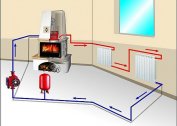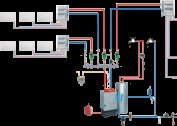To ensure the heat supply of a private house, different methods are used. The most common is gas heating. Thanks to him, it is possible to establish and maintain the required temperature in the premises in a short time. At the same time, the operation of a gas heating system requires a minimum amount of funds if the network is correctly designed and installed.
Used types of gas fuel for heating
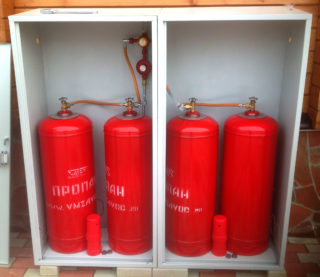 It is possible to organize a heating system in a private residential building based on ordinary natural gas or in a liquefied state. These two types of gaseous fuels are transported to the consumer in different ways. In the first case, a central gas pipeline is used, and in the second, special containers: gas holders and standard cylinders.
It is possible to organize a heating system in a private residential building based on ordinary natural gas or in a liquefied state. These two types of gaseous fuels are transported to the consumer in different ways. In the first case, a central gas pipeline is used, and in the second, special containers: gas holders and standard cylinders.
Gas heating
With this option, the organization of heat supply, gaseous fuel moves through the central pipeline system to the distribution equipment. It is a pressure reducer that balances the pressure between the trunk and the home network. After that, natural gas is used as fuel in a boiler - a common device for heating the coolant.
The heating scheme with the household system connected to the main gas pipeline eliminates the need to monitor the volume of gas in a special tank, since it is simply absent. The central pipeline allows the consumer to use any amount of heat. A limitation can only be financial opportunities. After all, the homeowner will have to pay bills every month.
 The consumer also needs to order a heating project. It will be implemented by specialists of a company that has permission to perform such processes. The owner of the house will have to pay a round sum for both the project documentation and for installation services, including the installation of an external and internal line. Such expenses usually amount to tens of thousands of rubles.
The consumer also needs to order a heating project. It will be implemented by specialists of a company that has permission to perform such processes. The owner of the house will have to pay a round sum for both the project documentation and for installation services, including the installation of an external and internal line. Such expenses usually amount to tens of thousands of rubles.
The developed documentation reflects:
- point of insertion into the main pipeline;
- gearbox calculation;
- scheme of the external line to the gas meter.
If changes are required in the project, they will have to be paid in full, which will increase already high costs. It is recommended to think over the entire heating system in advance to reduce costs.
Heating a house using natural gas from the main pipeline has the following advantages:
- uninterrupted heat generation scheme;
- creating the most comfortable living conditions;
- the possibility of using boiler equipment in any mode.
The negative aspects of the heating system based on natural gas from the main pipeline include damage by pipes to the appearance of the site and the facade of the house on which the piping is being performed.
LPG heating
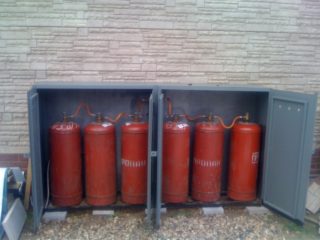 The use of this type of fuel allows not to connect to the central gas pipeline. This option for organizing heating is used in the following cases:
The use of this type of fuel allows not to connect to the central gas pipeline. This option for organizing heating is used in the following cases:
- the house is located at a significant distance from the gas main;
- connection to the central pipeline requires high costs that do not correspond to the budget of the homeowner;
- the pressure in the main gas pipeline often drops.
The positive aspects of the use of liquefied gas include the possibility of saving money, since it will not be necessary to carry out earthwork if the fuel is placed in special cylinders or a ground gas tank.Also, the owner of the house does not have to pay for the issuance of permits.
Installation of replaceable cylinders is carried out in special cabinets made of non-combustible material. Installation of the gas tank is carried out underground or on the surface. In the first case, the installation of the tank is carried out subject to the following minimum distances:
- to the house - 10 m;
- to the sewerage and a water supply system - 5 m;
- to the carriageway - 5 m;
- to power poles - 15 m.
With a ground-based installation of a gas tank, the minimum distance to a residential building should be 20 m, and to the road - 10 m. In other cases, it is equal to the values as when installing an underground tank.
Liquefied gas in replaceable cylinders and gas holders is under pressure from 15 to 18 atmospheres. During the application of the first type of containers, even with a capacity of 50 liters, they will often have to be changed depending on the power of the heating device or the set temperature regime. Using a gas tank allows you to worry less about the amount of gaseous fuel. The volume of such tanks can reach 20 cubic meters. meters.
Cylinders are cheaper to maintain compared to special tanks. The first tanks can be changed independently, and pumping gas into the gas holders in a liquefied state will be exclusively a special service. Therefore, large containers for storing gaseous fuels are more appropriate to use in multi-unit cottages.
Classification of gas heating according to the design of the heating device
During the organization of an autonomous heating system, different gas equipment is used that generates thermal energy. Such devices use trunk and liquefied gas as fuel.
Gas boiler
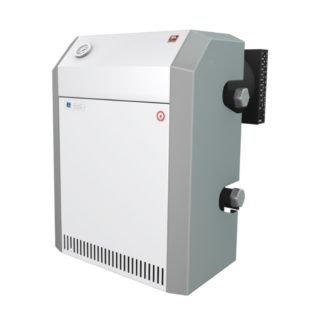 This device conducts heating of the coolant circulating through the pipes. It allows you to create a central heating system. Its basis is a boiler installed in a special room, and pipes fixed throughout the house. The gas pipeline is laid only to the heat generating unit. This allows you to save the exterior, but spoil the interior of the premises with pipes and batteries.
This device conducts heating of the coolant circulating through the pipes. It allows you to create a central heating system. Its basis is a boiler installed in a special room, and pipes fixed throughout the house. The gas pipeline is laid only to the heat generating unit. This allows you to save the exterior, but spoil the interior of the premises with pipes and batteries.
The type of boiler and its burner are selected depending on the power of the unit. When selecting equipment, the design and material of the heat exchanger are taken into account. In wall units, it is made of copper, and in floor models it is made of cast iron or steel.
When organizing heating, single-circuit and double-circuit boilers are used. The first version of the devices is designed exclusively for heating. Units with two circuits heat not only the coolant, but also the water used in everyday life. Such models are equipped with a boiler. In them, the water is heated by a burner or by means of an indirectly connected coil.
Consumers have the opportunity to pick up a gas boiler for a home with any area. So, for a two-story dwelling with a total area of 400 m2, a heat-generating installation with a capacity of 40 kW is suitable if the ceiling height in the rooms does not exceed 2.7 m. Otherwise, a more powerful unit will be needed.
Gas convector
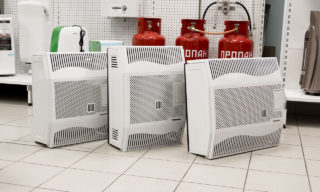 Another common option for organizing a heating system in a private house. When creating such a heat supply, gas cylinders are used. This option differs not only at an affordable price, but also with other advantages:
Another common option for organizing a heating system in a private house. When creating such a heat supply, gas cylinders are used. This option differs not only at an affordable price, but also with other advantages:
- Easy installation with standard hardware. Often, the laying of pipes is carried out independently, but the adjustment of heating devices must be carried out exclusively by professionals.
- High level of security, as the work is controlled by automation.
- Durability of 20 to 50 years.
Gas convectors can successfully fit into any interior due to their compactness. Such devices operate on main and liquefied gas. Autonomous use of convectors is carried out in the presence of replaceable cylinders.Their number for one device depends on the area of the heated room. The use of cylinders allows you to save money and quickly create the desired level of comfort. Thanks to the use of convectors, it is not necessary to carry out the installation of radiators and pipes designed to supply coolant.
Infrared gas emitter
 This type of equipment is one of the most advanced devices. It is installed in rooms with a large area. The equipment works on the principle of solar radiation. Consumers have the opportunity to buy a device with a capacity of 1.5 kW. Such emitters are suitable for heating the premises of country houses.
This type of equipment is one of the most advanced devices. It is installed in rooms with a large area. The equipment works on the principle of solar radiation. Consumers have the opportunity to buy a device with a capacity of 1.5 kW. Such emitters are suitable for heating the premises of country houses.
The device for infrared heating consists of a housing. It contains a reflector directed towards the floor. There is also a ceramic nozzle in the form of flat-shaped tiles with holes. Gas is supplied between the body and the nozzle. Gaseous fuel heats ceramic tiles. After heating, the gas is already burning directly on the nozzle. The advantage of this heat supply method is the almost complete absence of fuel combustion products. Small residues are removed from the room by ventilation.
Other gas heating options
 Every year in homes increasingly arrange air gas heating. Previously, it was used exclusively at enterprises, in shopping centers and warehouse complexes. The principle of operation of such devices is to supply air through a heat exchanger. Devices differ in power, type of fan and coolant.
Every year in homes increasingly arrange air gas heating. Previously, it was used exclusively at enterprises, in shopping centers and warehouse complexes. The principle of operation of such devices is to supply air through a heat exchanger. Devices differ in power, type of fan and coolant.
As additional heating for utility rooms in houses, gas guns can be used. Heating devices of this type are most often connected to cylinders. Therefore, they are characterized by mobility. The devices carry out direct heating and they do not provide for the removal of combustion products.
Alternative options for gas heating also include hydrogen plants. They run on Brown gas. Applied devices for heating residential premises of different sizes. They have the following advantages:
- profitability;
- minimum amount of combustion products;
- environmental friendliness.
Hydrogen plants are sold in specialized stores. They can even be made independently if you have the appropriate knowledge and skills in the field of heating equipment.
Instead of a conclusion
Of all the existing options for gas heating of the house, the most common is the water system, consisting of a boiler that runs on main fuel. A large number of models allows you to choose a device for a specific area, and gas from the central pipeline will provide uninterrupted heat supply to housing. Moreover, it is possible to install a double-circuit boiler, heating not only the coolant, but also water for domestic needs.
If it is not possible to connect the home network to the central gas pipeline, it is recommended to install the required volume on the gas tank section. It will allow for a long time to uninterruptedly provide the house with heat, without worrying every 2-3 days about the volume of liquefied gas in the tank. Portable cylinders do not have this advantage.
However, systems based on convectors operating on liquefied gas are the easiest to install. When organizing such heating, you can not even lay pipelines if you use special cylinders.
